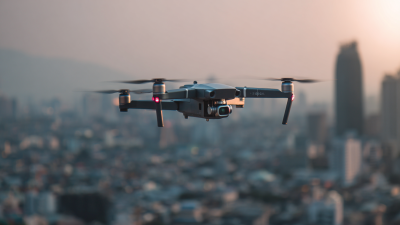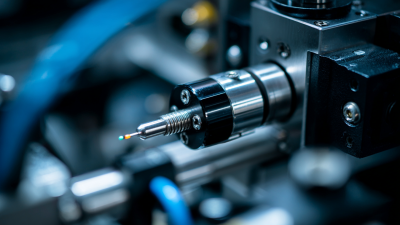Understanding Proximity Sensor Challenges in Industrial Applications
Table of Contents
- The Importance of Proximity Sensors in Modern Industrial Environments
- Common Challenges Faced by Proximity Sensors in Industrial Settings
- Innovative Solutions to Overcome Proximity Sensor Limitations
- Best Practices for Implementing Proximity Sensors in Industry
- Future Trends: Enhancing Proximity Sensor Technology for Industry 4.0
- Case Studies: Successful Applications of Proximity Sensors in Various Industries
- FAQS
- Conclusion
- Related Posts
When it comes to smart manufacturing, really understanding how proximity sensors work is a big deal if you want to keep things running smoothly. These sensors—like inductive, photoelectric, and capacitive ones—are the backbone of many automation processes, offering precise and dependable performance. But, of course, they come with their own set of challenges. So, if you’re wondering, “Apa Itu Proximity Sensor?”—you're not alone. There are common issues to watch out for, like environmental conditions, installation hiccups, or compatibility problems with existing systems. Knowing this stuff helps us see why companies like Shanghai Lanbao Sensing Technology Co., Ltd are such key players when it comes to providing top-notch components for intelligent manufacturing. By understanding how these sensors work and the hurdles they face, we can better appreciate the innovations and solutions that companies like ours bring to the table—helping to make industrial processes more efficient and reliable.

The Importance of Proximity Sensors in Modern Industrial Environments
You know, in today's industrial settings, proximity sensors are pretty much essential when it comes to making things run smoothly and safely. They help automation systems
Understanding Proximity Sensor Challenges in Industrial Applications
Common Challenges Faced by Proximity Sensors in Industrial Settings
You know, in the world of industrial stuff, proximity sensors are kind of a big deal—they really help make things run smoother and more accurately. But, honestly, they’ve got their hurdles too. I came across this recent report from MarketsandMarkets, and it says the global market for these sensors is predicted to hit around $2.67 billion by 2025. That just shows how much everyone’s counting on these tech bits. Still, they’re not perfect—things like electromagnetic interference, temperature swings, and needing really solid calibration can mess with their performance, sometimes causing costly downtime just when you least need it.
One of the trickiest parts? Industries often operate in dusty, damp, or super hot environments, and all that stuff can really mess with sensors being reliable. Plus, false triggers—like when nearby machinery bumps into them—can throw off readings, which is a pain. According to a study from ResearchAndMarkets, about 40% of sensor failures in factories are due to these environmental issues. But it’s not all bad news.
Companies like Shanghai Lanbao Sensing Technology are stepping up with smarter solutions—things like intelligent inductive and photoelectric sensors built tough enough to handle harsh conditions. These new gadgets don’t just solve the old problems—they’re also helping push forward smarter, more reliable manufacturing systems, which is pretty exciting.
Innovative Solutions to Overcome Proximity Sensor Limitations
Proximity sensors are a pretty essential part of industrial automation these days, but they do have some pretty frustrating limitations that can slow things down. One big issue is how sensitive they are to environmental factors—stuff like temperature swings, dust, or electromagnetic interference can really mess with their performance. Interestingly, a recent report from the International Society of Automation (ISA) mentioned that about 30% of sensor failures in tough industrial settings are caused by exactly these kinds of environmental issues. As industries aim for more reliable and precise operations, finding ways to tackle these problems is more important than ever.
To make proximity sensors more durable and reliable, manufacturers are getting pretty creative. For example, they’re working on advanced materials and new tech. One exciting development is the rise of self-calibrating sensors, which can actually fine-tune their sensitivity on the fly, based on what's going on around them. Plus, bringing artificial intelligence into the mix is a game changer—it helps analyze data patterns and even predict potential issues before they happen. A report from MarketsandMarkets estimates that the smart sensor market could hit USD 69 billion by 2025, which shows how serious the industry is about using technology to get around these challenges. All of this means not only better accuracy, but also longer-lasting sensors in tough industrial environments—that’s a win all around.

Best Practices for Implementing Proximity Sensors in Industry
When you're working with proximity sensors in industrial setups, there are a few key tips that can really make a difference in how well everything works and how reliable the sensors are. First off, you wanna take a good look at the environment where you're planning to put them. Things like temperature swings, humidity, and any other equipment that might mess with the signals should be considered. That way, you can pick the right type of sensor—whether it's capacitive, inductive, or ultrasonic—that suits the conditions best. Placement is also super important; aim to set them up where they won't get blocked or disturbed, so they can detect objects effectively over a good range of distance.

Another thing is keeping the sensors in tip-top shape. Regular cleaning and calibration are your friends here—they help keep things accurate. Dust and grime can mess with the readings, so a quick clean now and then really helps. Plus, recalibrating from time to time ensures the sensors are still responding correctly to what's around them. And if you hook them up to a solid communication system, it’s a game changer—alerts and real-time monitoring can save you a lot of headaches by catching issues early. Follow these simple but solid practices, and you’ll get much better performance out of your proximity sensors, making operations smoother and safer overall.
Future Trends: Enhancing Proximity Sensor Technology for Industry 4.0
Proximity sensors might not be the most glamorous tech out there, but they’re actually pretty vital in industrial settings. They help detect things like how close objects are or if something is even there—powers that really help boost efficiency and keep everything running smoothly. As we step further into the era of Industry 4.0, it’s clear that the demand for more advanced proximity sensor tech is growing fast. Recent market reports show that China’s industrial sensor market has really taken off; it jumped from about 26.75 billion yuan back in 2016, mainly because companies are pushing hard for smarter manufacturing and more automation.
One tricky part about using these sensors in industrial environments is keeping their accuracy sharp, especially when things are always changing. As industries become more connected—think smart factories—having sensors that can deliver real-time data is more critical than ever. That’s where innovations like IoT integration and machine learning come in. They’re helping develop smarter sensors that can adapt to different conditions and gather better data. Market predictions suggest this trend isn’t slowing down anytime soon. The whole sector is expected to keep climbing, with manufacturers placing a big emphasis on sensor precision and reliability to make their production lines more efficient and effective.
Case Studies: Successful Applications of Proximity Sensors in Various Industries
Proximity sensors are becoming pretty important across a bunch of industries these days. They’re offering some really cool solutions to make things safer and more efficient. Take aerospace and defense, for example — these sensors help with pinpointing objects and avoiding collisions, which is a total must in high-stakes situations. In the automotive world, you see them used for parking assist and even for self-driving features, making driving smoother and safer at the same time. And when it comes to building automation, they’re key for saving energy by controlling lights based on whether someone’s in the room or not.
If you look at some real-world examples, it’s clear just how versatile these sensors are. In manufacturing, they’re often integrated into robots to get really precise in assembling stuff, which cuts down on mistakes and boosts productivity. As industries push toward smarter factories, the demand for advanced sensors is heating up. Regions like Asia-Pacific are seeing a lot of growth, driven by rapid industrialization and tech progress. Overall, as the global market for proximity sensors keeps growing, it’s pretty clear they’re helping industries go automated and smarter — a trend that’s here to stay.
FAQS
: Proximity sensors face limitations such as sensitivity to environmental conditions like temperature fluctuations, dust, and electromagnetic interference, which can affect their performance. Around 30% of sensor failures in industrial settings are attributed to these environmental influences.
Manufacturers are exploring advanced materials and technologies, such as self-calibrating sensors that adjust sensitivity in real-time and the integration of artificial intelligence (AI) to optimize functionality and predict performance issues.
According to a study by MarketsandMarkets, the smart sensor market is projected to grow to USD 69.0 billion by 2025, indicating a strong commitment within the industry to leverage technology for overcoming challenges.
Best practices include carefully assessing the installation environment for factors like temperature and humidity, proper placement to minimize obstructions, and regular maintenance and calibration to ensure accuracy.
Regular maintenance, including periodic cleaning and recalibration, is essential to maintain sensor accuracy and performance, as dust or debris can hinder functionality.
Integrating proximity sensors with a robust communication system facilitates real-time monitoring, allowing for quick adjustments and maintenance alerts, thereby improving operational efficiency and safety.
Common types of proximity sensors used in industrial settings include capacitive, inductive, and ultrasonic sensors, each suited for different environmental conditions and application needs.
Environmental factors such as dust, temperature variations, humidity levels, and interference from other equipment can negatively impact the performance and reliability of proximity sensors in industrial applications.
Artificial intelligence can optimize proximity sensor functionality by analyzing data patterns and predicting potential performance issues before they occur, thereby enhancing overall reliability.
Self-calibrating sensors provide the benefit of adjusting their sensitivity in real-time based on current environmental conditions, which enhances their robustness and accuracy in detection.
Conclusion
You know, in today's industrial setups, proximity sensors are pretty much essential for keeping things running smoothly and boosting efficiency. But it’s not all smooth sailing—these sensors face some real hurdles like environmental noise, reliability issues, and limited range that can sometimes cause headaches. Still, industry folks are always working on clever new solutions to get past these problems, especially as the push towards smarter, more connected factories—think Industry 4.0—keeps growing. Companies like Shanghai Lanbao Sensing Technology Co., Ltd are really leading the charge here, offering high-tech options like intelligent inductive, photoelectric, and capacitive sensors.
So, what exactly is a proximity sensor? Simply put, it’s a tech gadget that detects objects nearby without even touching them—super handy in all sorts of industrial jobs. Getting the hang of best practices with these sensors can seriously ramp up efficiency and safety at work. Plus, looking at real-world success stories really shows just how much these sensors can change the game, making factories more automated and smarter than ever before. It’s exciting to see how much potential there is for the future of manufacturing!
Related Posts
-

Future Trends: Market Dynamics for Best Prox Sensors by 2025
-

The Ultimate Guide to Understanding the Purpose of Proximity Sensors in Modern Industries
-

The Ultimate Guide to Understanding Proximity Sensors: Applications and Benefits Explained
-

Exploring Alternative Technologies for Magnetic Sensor Proximity Solutions
-

10 Reasons Inductive Proximity Sensors are the Best Choice for Your Automation Needs
-

Chinese Excellence in Manufacturing the Best M8 Inductive Proximity Sensor for Global Markets

